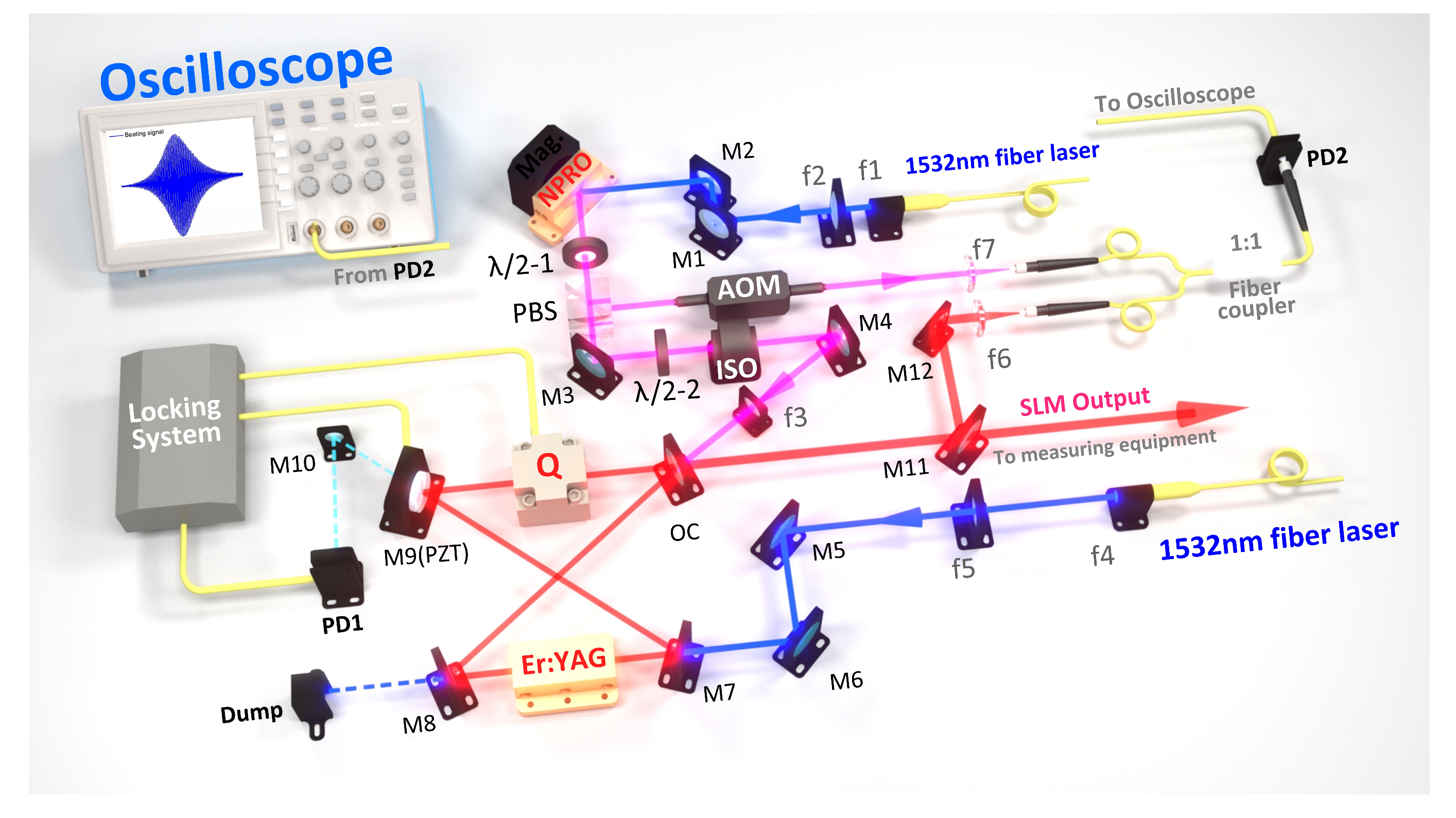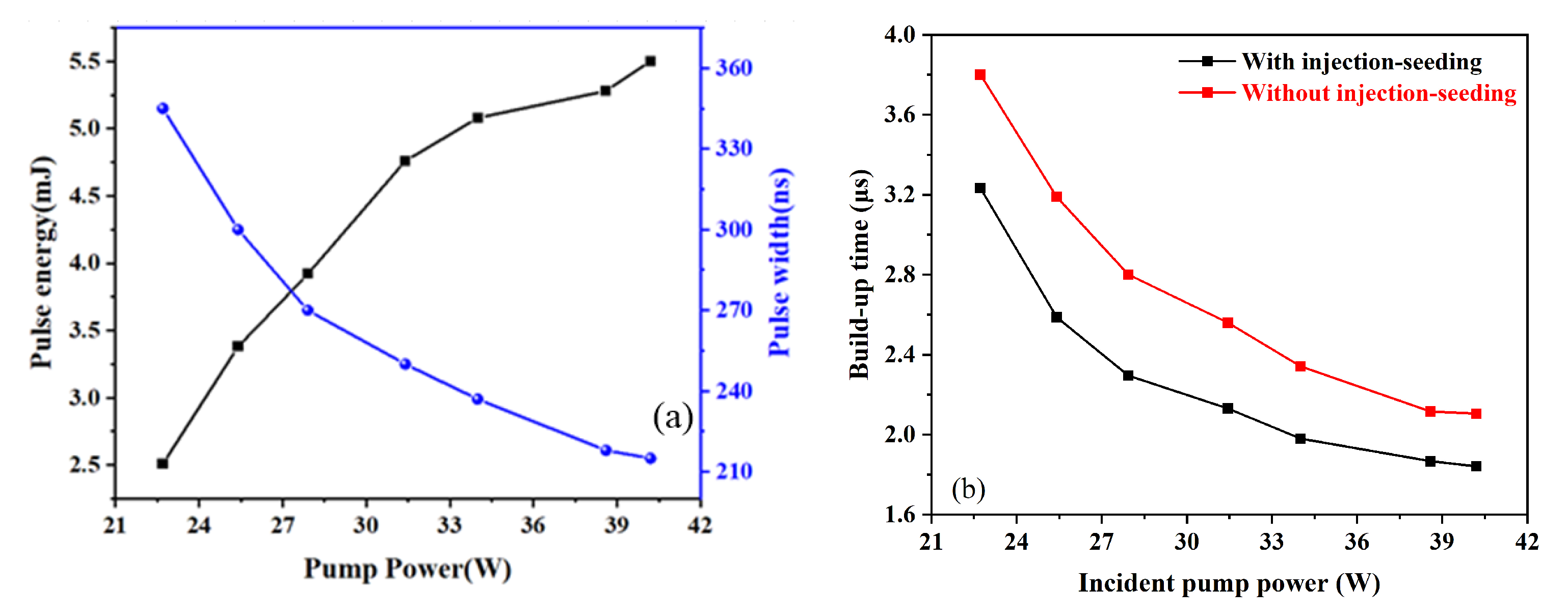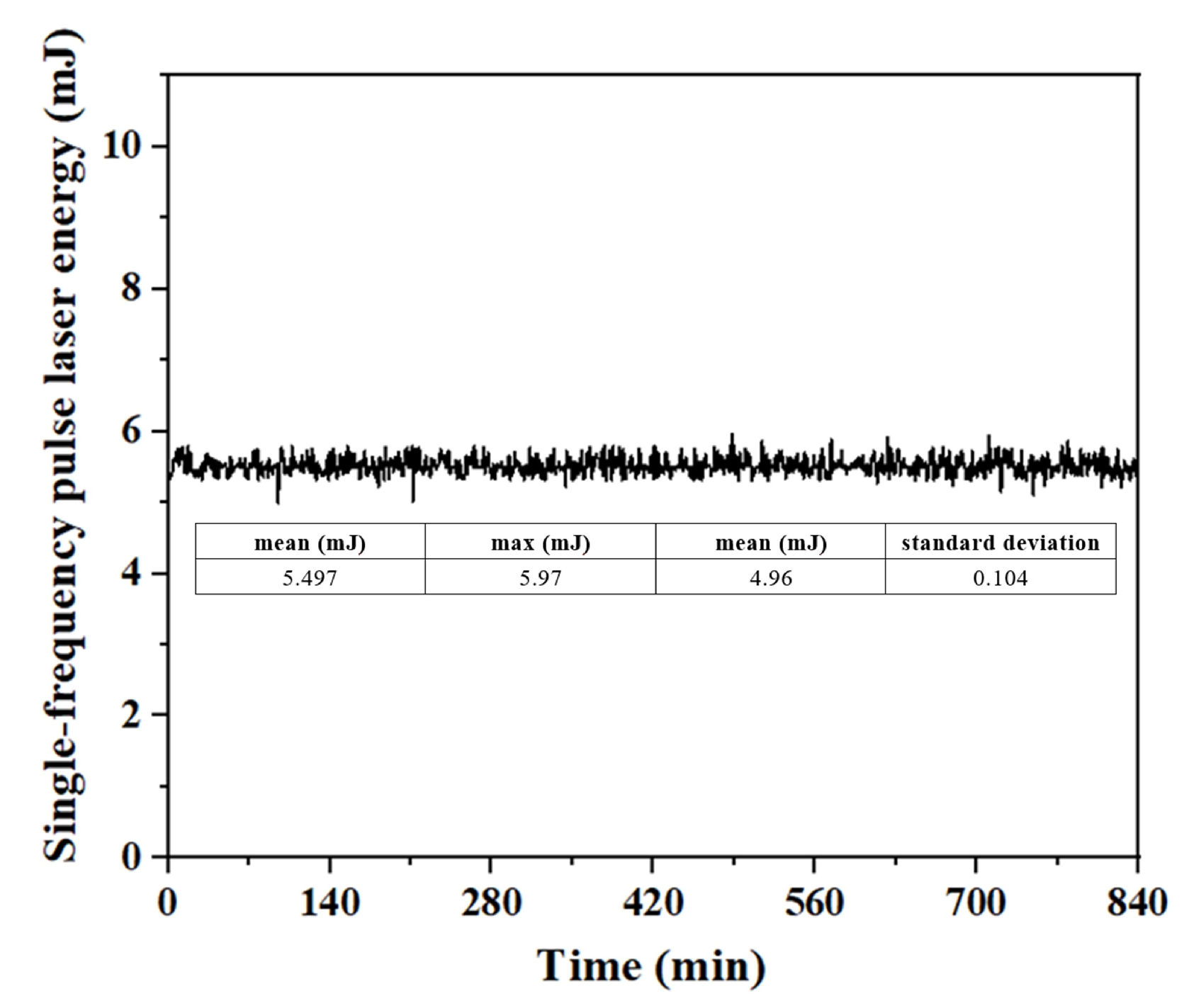High-Energy Injection-Seeded Single-Frequency Er:YAG Laser at 1645 nm Pumped by a 1532 nm Fiber Laser
Abstract
1. Introduction
2. Experimental Setup
3. Experimental Results and Discussion
4. Conclusions
Author Contributions
Funding
Institutional Review Board Statement
Informed Consent Statement
Data Availability Statement
Conflicts of Interest
References
- Stoneman, R.C.; Hartman, R.; Malm, A.I.R.; Gatt, P. Coherent laser radar using eyesafe Er: YAG laser transmitters. Laser Radar Technology and Applications X; SPIE: Bellingham, WA, USA, 2005; Volume 5791, pp. 167–174. [Google Scholar]
- Buck, J.; Malm, A.; Zakel, A.; Krause, B.; Tiemann, B. Multi-function coherent ladar 3D imaging with S3. In Electro-Optical Remote Sensing, Detection, and Photonic Technologies and Their Applications; SPIE: Bellingham, WA, USA, 2007; Volume 6739, pp. 134–144. [Google Scholar]
- Cezard, N.; Le Mehaute, S.; Le Gouët, J.; Valla, M.; Goular, D.; Fleury, D.; Planchat, C.; Dolf-Bouteyre, A. Performance assessment of a coherent DIAL-Doppler fber lidar at 1645 nm for remote sensing of methane and wind. Opt. Express 2020, 28, 22345–22357. [Google Scholar] [CrossRef] [PubMed]
- Wang, K.X.; Gao, C.Q.; Lin, Z.; Wang, Q.; Gao, M.W.; Huang, S.; Chen, C.Y. 1645 nm coherent Doppler wind lidar with a single-frequency Er:YAG laser. Opt. Express 2020, 28, 14694–14704. [Google Scholar] [CrossRef] [PubMed]
- Stephan, C.; Alpers, M.; Millet, B.; Ehret, G.; Flamant, P.; Deniel, C. MERLIN: A space-based methane monitor. In Lidar Remote Sensing for Environmental Monitoring XII; SPIE: Bellingham, WA, USA, 2011; Volume 8159, p. 815908. [Google Scholar]
- Park, Y.K.; Giuliani, G.; Byer, R.L. Stable single-axial-mode operation of an unstable-resonator Nd: YAG oscillator by injection locking. Opt. Lett. 1980, 5, 96–98. [Google Scholar] [CrossRef] [PubMed]
- Cong, Z.H.; Liu, Z.J.; Qin, Z.G.; Zhang, X.Y.; Wang, S.H.; Rao, H.; Fu, Q. RTP Q-switched single-longitudinalmode Nd:YAG laser with a twisted-mode cavity. Appl. Opt. 2015, 54, 5143–5146. [Google Scholar] [CrossRef] [PubMed]
- Fan, J.W.; Ju, Y.L.; Wu, J.Z.; Yan, D.; Duan, X.M.; Yao, B.Q.; Dai, T.Y. Seed-injection Er: LuAG single-frequency, pulsed laser at 1650 nm. Infrared Phys. Technol. 2024, 139, 105325. [Google Scholar] [CrossRef]
- Wang, Q.; Gao, C.Q.; Na, Q.X.; Zhang, Y.X.; Ye, Q.; Gao, M.W. Single-frequency injection-seeded Q-switched Ho: YAG laser. Appl. Phys. Express 2017, 10, 042701. [Google Scholar] [CrossRef]
- Long, J.X.; Li, G.; Yang, B.; Yao, H.Q.; Ding, J.Y. Injection-Seeded 500 Hz Repetition Rate High Peak Power Single-Frequency Nd: YAG Laser for Mid-Infrared Generation. J. Russ. Laser Res. 2018, 39, 600–607. [Google Scholar] [CrossRef]
- Yan, D.; Yuan, Y.; Wang, Y.P.; Fan, J.W.; Wu, J.Z.; Duan, X.M.; Li, S.N.; Dai, T.Y.; Ju, Y.L. High-energy, alignment-insensitive, injection-seeded Q-switched Ho:yttrium aluminum garnet single-frequency laser. High Power Laser Sci. Eng. 2023, 11, e66. [Google Scholar] [CrossRef]
- Deng, Y.; Yu, X.; Yao, B.Q.; Dai, T.Y.; Duan, X.M.; Ju, Y.L. Single-frequency, Q-switched Er: YAG at room temperature injection-seeded by an Er: YAG nonplanar ring oscillator. Laser Phys. 2014, 24, 045809. [Google Scholar] [CrossRef]
- Gao, C.Q.; Shi, Y.; Ye, Q.; Wang, S.; Na, Q.X.; Wang, Q.; Gao, M.W. 10 mJ single-frequency, injection-seeded Q-switched Er: YAG laser pumped by a 1470 nm fiber-coupled LD. Laser Phys. Lett. 2018, 15, 025003. [Google Scholar] [CrossRef]
- Zhang, Y.; Gao, C.Q.; Wang, Q.; Na, Q.X.; Zhang, M.; Gao, M.W.; Huang, S. 1 kHz single-frequency, injection-seeded Er: YAG laser with an optical feedback. Chin. Opt. Lett. 2019, 17, 031402. [Google Scholar] [CrossRef]
- Huang, S.; Wang, Q.; Zhang, M.; Chen, C.Y.; Wang, K.X.; Gao, M.W.; Gao, C.Q. A 3-kHz Er: YAG single-frequency laser with a ‘triple-reflection’ configuration on a piezoelectric actuator. Chin. Phys. B 2020, 29, 084204. [Google Scholar] [CrossRef]
- Zhang, Z.G.; Ju, Y.L. Injection-seeded Q-switched laser based on a double corner cube retroreflector ring cavity. Opt. Express 2021, 29, 41954–41963. [Google Scholar] [CrossRef]
- Fan, J.W.; Wu, J.Z.; Ju, Y.L.; Yan, D.; Yang, X.B.; Yuan, Y.; Duan, X.M.; Dai, T.Y. 500 Hz single-frequency, pulsed Er: YAG laser in the double corner cube retroreflector resonator. Infrared Phys. Technol. 2023, 134, 104907. [Google Scholar] [CrossRef]
- Shi, Y.; Gao, C.Q.; Wang, S.; Li, S.H.; Song, R.; Zhang, M.; Gao, M.W.; Wang, Q. High-energy, single-frequency, Q-switched Er:YAG laser with a double-crystals-end-pumping architecture. Opt. Express 2019, 27, 2671–2680. [Google Scholar] [CrossRef] [PubMed]
- Li, S.H.; Wang, Q.; Song, R.; Hou, F.F.; Gao, M.W.; Gao, C.Q. Laser diode pumped high-energy single-frequency Er: YAG laser with hundreds of nanoseconds pulse duration. Chin. Opt. Lett. 2020, 18, 031401. [Google Scholar] [CrossRef]
- Chen, C.Y.; Gao, C.Q.; Wang, Q. Injection-seeded 10 kHz repetition rate Er: YAG solid-state laser with single-frequency pulse energy more than 1 mJ. Opt. Express 2022, 30, 16044–16052. [Google Scholar] [CrossRef] [PubMed]
- Henderson, S.W.; Yuen, E.H.; Fry, E.S. Fast resonance-detection technique for single-frequency operation of injection-seeded Nd: YAG lasers. Opt. Lett. 1986, 11, 715–717. [Google Scholar] [CrossRef] [PubMed]
- Zhao, Z.A.; Bai, Z.X.; Jin, D.; Qi, Y.Y.; Ding, J.; Yan, B.Z.; Wang, Y.L.; Lv, Z.W.; Mildren, R.P. Narrow laser-linewidth measurement using short delay self-heterodyne interferometry. Opt. Express 2022, 30, 30600–30610. [Google Scholar] [CrossRef] [PubMed]






| References | Years | Gain Medium | Pumping Source | Beam Quality |
|---|---|---|---|---|
| [18] | 2019 | double Er:YAG | 1470 nm LD + 1532 nm fiber laser | 1.27, 1.30 |
| [4] | 2020 | Er:YAG cemamics | 1470 nm LD + 1532 nm fiber laser | 1.51, 1.55 |
| [19] | 2020 | double Er:YAG | 1470 nm LD | 1.37, 1.09 |
| [20] | 2022 | Er:YAG | 1470 nm LD + 1532 nm fiber laser | \ |
| [17] | 2023 | Er:YAG | both 1532 nm fiber laser | 1.2, 1.24 |
| This paper | 2024 | Er:YAG | both 1532 nm fiber laser | 1.18, 1.21 |
Disclaimer/Publisher’s Note: The statements, opinions and data contained in all publications are solely those of the individual author(s) and contributor(s) and not of MDPI and/or the editor(s). MDPI and/or the editor(s) disclaim responsibility for any injury to people or property resulting from any ideas, methods, instructions or products referred to in the content. |
© 2024 by the authors. Licensee MDPI, Basel, Switzerland. This article is an open access article distributed under the terms and conditions of the Creative Commons Attribution (CC BY) license (https://creativecommons.org/licenses/by/4.0/).
Share and Cite
Wu, J.; Ju, Y.; Fan, J.; Zhao, Y.; Yang, K.; Geng, L.; Cai, Y.; Song, L.; Zhuang, Y.; Wu, S.; et al. High-Energy Injection-Seeded Single-Frequency Er:YAG Laser at 1645 nm Pumped by a 1532 nm Fiber Laser. Photonics 2024, 11, 752. https://doi.org/10.3390/photonics11080752
Wu J, Ju Y, Fan J, Zhao Y, Yang K, Geng L, Cai Y, Song L, Zhuang Y, Wu S, et al. High-Energy Injection-Seeded Single-Frequency Er:YAG Laser at 1645 nm Pumped by a 1532 nm Fiber Laser. Photonics. 2024; 11(8):752. https://doi.org/10.3390/photonics11080752
Chicago/Turabian StyleWu, Jiaze, Youlun Ju, Jiawei Fan, Yiming Zhao, Kun Yang, Lijie Geng, Yuanxue Cai, Lei Song, Yaming Zhuang, Shuyun Wu, and et al. 2024. "High-Energy Injection-Seeded Single-Frequency Er:YAG Laser at 1645 nm Pumped by a 1532 nm Fiber Laser" Photonics 11, no. 8: 752. https://doi.org/10.3390/photonics11080752
APA StyleWu, J., Ju, Y., Fan, J., Zhao, Y., Yang, K., Geng, L., Cai, Y., Song, L., Zhuang, Y., Wu, S., & Duan, X. (2024). High-Energy Injection-Seeded Single-Frequency Er:YAG Laser at 1645 nm Pumped by a 1532 nm Fiber Laser. Photonics, 11(8), 752. https://doi.org/10.3390/photonics11080752







